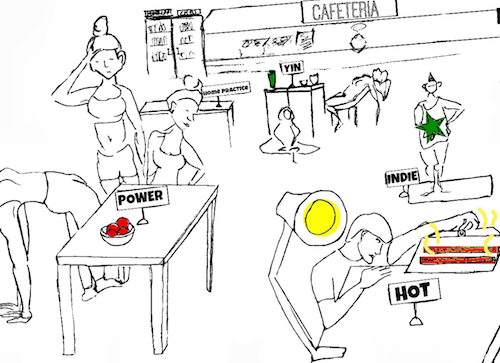
Coloradoans know the best kind of ski pass is one that includes many mountains; this is for diversity of terrain, varying daily weather and/or snow conditions, convenience, and coolness/steeze, among other factors.
Such a balance and bargain is not known to yoga, where membership to one studio virtually precludes belonging to another.
Because of price, and perhaps time, it’s rare to meet someone with two unlimited yoga memberships, let alone access to four or five different studios.
Such exclusivity has perks.
Yoga is as much physical asana as it is physical presence in the studio. Holding consistent company with like-minded individuals contributes to a safe space of growth and vulnerability, an affirming “vibe.”
Thus, while the mere largeness of mountains makes kumbaya an unrealistic goal of snow sports, community is integral to yoga studios. And, it cannot be facilitated when a studio’s yogis appear only weekly or monthly. Community is fostered when we see the same chick at 7:30 a.m. as we did at 8:30 p.m. the night before: a communal gesture of:
“Hey, I’m back. This is my commitment.”
On the other hand, sole attendance at one studio (and the confined perspective that follows) undoubtedly limits one’s spiritual and physical potential.
Instructors tend to be trained by the yoga studio where they teach, or at least adhere to a set values system, vision or leader.
It’s no surprise that classes within studios are often similar. And, while variance may exist between sequences, there are usually only one or two styles offered at a given studio.
As a consequence, modern yogis are segregated into narrow classifications: Hot, Vinyasa, Power, Kundalini, Ashtanga, Yin—among dozens of others.
At best, this segregation makes yogis miss out on the beauty of yoga’s diverse asanas, approaches and uses.
At worst, it causes cattiness, cliques, hypocrisy and closed-mindedness.
When a Power yogi meets a Yin yogi, they may bond over loose hamstrings, but that’s about all they have in common under the modern mindset.
Is a good stretch actually all differing styles have in common?
In our current segregated system, maybe; but according to ancient—and even half-century old—texts, they are all one.
Yoga means unity.
The Chinese precepts of Yin and Yang posit that equilibrium of opposites dictates the optimal fulfillment of each. Accordingly, Power yogis should abandon mountain climbers for a weekly Yin class to slow their bunny heartbeats; Yin yogis should get off their ass-anas for a plank occasionally. Balance.
But in forcing, or even inviting, a mixer between tables at the yogi cafeteria, would we lose that comfortable—important—fit of Self in community? If there were a Five Mountain Pass of yoga studios, would we sacrifice our sense of belonging to the diversification of our personal practice?
The question is ultimately whether community and diversity are mutually exclusive.
No. They’re not.
Here’s why:
First, knowing what else is out there enhances one’s connection and commitment to her community.
Once I was in a relationship where I didn’t know what I had until it was gone.
Familiar?
When we leave what we know, we return with renewed appreciation and relevant experience; or, we move on to something better suiting.
A multi-studio “pass” is playing the field. We’ll likely eventually migrate toward one style or another, but a sustained search is critical to our perception of our ultimate find. And, our find continues to be enhanced by our dedication to routinely experience beyond it (see: Boulder, Colorado, 1960s “Free Love”).
Second, “affirmative action” ensures balance—a critical component of not only one’s personal practice but also any broader community.
Just as colleges need students from varied backgrounds to compose an educated, broad-minded class, studios need more than one type of yogi to create a comprehensive community conducive to learning and liberation of the mind.
The Power studio needs the Yin yogi as much as the Yin yogi needs Power!
Thus, diversity produces equity; by attempting different styles, we craft a more fair, equal, inclusive worldwide community.
Though affirmative action is contentious, we can agree that each population segment—or, for this article’s purposes, yoga style—should be represented to a degree; the exact extent is the subject of debate.
What’s the magic “extent” of variety on our mats?
At a basic level, a diversification quota should complement our commitment to our home base membership and community.
Dancer’s Pose is a microcosm of this tension. It necessitates we ground down through the standing leg and find stability to then reach out with the free arm and push out with the bound leg: a balance of stationary, rooted strength and active extension.
I propose studios fix yoga cliques by augmenting primary memberships with an optional number of days per month at an assortment of local studios.
This partnership would result in an expansion of both the yogi’s universe and each studio’s revenue. The collaboration would keep the home community unscathed (or even improved) because students would diversify only a few times a month, not every day.
This small shift spawns a culture of acceptance and goodwill in place of elitism.
For example, the Rocky Mountain Super Pass supplements its unlimited access to Copper and Winter Park with a few days at Crested Butte, Steamboat and a mountain in New Zealand. Pass holders spend the majority of their time and money at Copper and Winter Park; but allowing riders to venture elsewhere seeds appreciation for home, new skills from varied terrain and, perhaps, friends around the globe. It also gets the word out about cool underdog resorts nobody would have thought to visit otherwise.
Why can’t we just have single-studio memberships and occasionally pay for drop-ins at other studios?
We can, but we don’t!
We have no incentive to leave our comfortable bubbles. In fact, the ungodly average drop-in rate of $20 per class disincentivizes us to open our minds; it’s institutionalized discrimination based on fear that the consumer will shop elsewhere.
The job of yoga studios is to lift up, inspire and educate their students. What better way to do that than this?
In short, expansion of yoga experience by means of a more encompassing membership package would integrate a diversification of styles, instigate more empathetic, better-informed personal practices and incite a united global yoga community.
Down with yoga supremacism.
Connection, collaboration and balance. Pass it on.
Love elephant and want to go steady?
Sign up for our (curated) daily and weekly newsletters!
Apprentice Editor: Brandie Smith/Editor: Catherine Monkman
Photo: Author’s Own.











Read 1 comment and reply